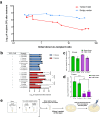Conjugative type IV secretion systems enable bacterial antagonism that operates independently of plasmid transfer
- PMID: 38664513
- PMCID: PMC11045733
- DOI: 10.1038/s42003-024-06192-8
Conjugative type IV secretion systems enable bacterial antagonism that operates independently of plasmid transfer
Abstract
Bacterial cooperation and antagonism mediated by secretion systems are among the ways in which bacteria interact with one another. Here we report the discovery of an antagonistic property of a type IV secretion system (T4SS) sourced from a conjugative plasmid, RP4, using engineering approaches. We scrutinized the genetic determinants and suggested that this antagonistic activity is independent of molecular cargos, while we also elucidated the resistance genes. We further showed that a range of Gram-negative bacteria and a mixed bacterial population can be eliminated by this T4SS-dependent antagonism. Finally, we showed that such an antagonistic property is not limited to T4SS sourced from RP4, rather it can also be observed in a T4SS originated from another conjugative plasmid, namely R388. Our results are the first demonstration of conjugative T4SS-dependent antagonism between Gram-negative bacteria on the genetic level and provide the foundation for future mechanistic studies.
© 2024. The Author(s).
Conflict of interest statement
The authors declare no competing interest.
Figures





Similar articles
-
Protein Transfer through an F Plasmid-Encoded Type IV Secretion System Suppresses the Mating-Induced SOS Response.mBio. 2021 Aug 31;12(4):e0162921. doi: 10.1128/mBio.01629-21. Epub 2021 Jul 13. mBio. 2021. PMID: 34253063 Free PMC article.
-
Conjugative Transfer of IncP-9 Catabolic Plasmids Requires a Previously Uncharacterized Gene, mpfK, Whose Homologs Are Conserved in Various MPFT-Type Plasmids.Appl Environ Microbiol. 2019 Nov 27;85(24):e01850-19. doi: 10.1128/AEM.01850-19. Print 2019 Dec 15. Appl Environ Microbiol. 2019. PMID: 31604768 Free PMC article.
-
Structural biology of the Gram-negative bacterial conjugation systems.Trends Microbiol. 2015 May;23(5):301-10. doi: 10.1016/j.tim.2015.02.012. Epub 2015 Mar 27. Trends Microbiol. 2015. PMID: 25825348 Review.
-
Characteristics of the Conjugative Transfer System of the IncM Plasmid pCTX-M3 and Identification of Its Putative Regulators.J Bacteriol. 2018 Aug 24;200(18):e00234-18. doi: 10.1128/JB.00234-18. Print 2018 Sep 15. J Bacteriol. 2018. PMID: 29986941 Free PMC article.
-
Molecular basis of conjugation-mediated DNA transfer by gram-negative bacteria.Curr Opin Struct Biol. 2025 Feb;90:102978. doi: 10.1016/j.sbi.2024.102978. Epub 2025 Jan 16. Curr Opin Struct Biol. 2025. PMID: 39823762 Review.
Cited by
-
Whole genome sequencing analysis of enteropathogenic Escherichia coli from human and companion animals in Korea.J Vet Sci. 2025 Jan;26(1):e1. doi: 10.4142/jvs.24225. Epub 2024 Dec 2. J Vet Sci. 2025. PMID: 39749377 Free PMC article.
-
The association between the genetic structures of commonly incompatible plasmids in Gram-negative bacteria, their distribution and the resistance genes.Front Cell Infect Microbiol. 2024 Nov 26;14:1472876. doi: 10.3389/fcimb.2024.1472876. eCollection 2024. Front Cell Infect Microbiol. 2024. PMID: 39660283 Free PMC article. Review.
-
A bacterial toxin-antitoxin system involved in an unusual response to genotoxic stress.EMBO Rep. 2025 Aug 18. doi: 10.1038/s44319-025-00545-y. Online ahead of print. EMBO Rep. 2025. PMID: 40825874
-
The extended mobility of plasmids.Nucleic Acids Res. 2025 Jul 19;53(14):gkaf652. doi: 10.1093/nar/gkaf652. Nucleic Acids Res. 2025. PMID: 40694848 Free PMC article. Review.
-
The type II secretion system as an underappreciated and understudied mediator of interbacterial antagonism.Infect Immun. 2024 Aug 13;92(8):e0020724. doi: 10.1128/iai.00207-24. Epub 2024 Jul 9. Infect Immun. 2024. PMID: 38980047 Free PMC article. Review.
References
-
- Gupta, A., Gupta, R. & Singh, R. L. Microbes and Environment. in Principles and Applications of Environmental Biotechnology for a Sustainable Future 43–84 (Springer, Singapore). 10.1007/978-981-10-1866-4_3. (2017).
-
- Finlay BJ, Maberly SC, Cooper JI. Microbial diversity and ecosystem function. Oikos. 1997;80:209. doi: 10.2307/3546587. - DOI
-
- Dodds, W. K. & Whiles, M. R. Microbes and Plants. in Freshwater Ecology 211–249 (Elsevier). 10.1016/B978-0-12-813255-5.00009-0. (2020)
Publication types
MeSH terms
Substances
Grants and funding
LinkOut - more resources
Full Text Sources
Molecular Biology Databases

